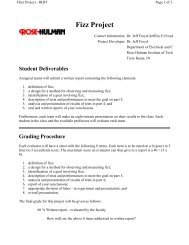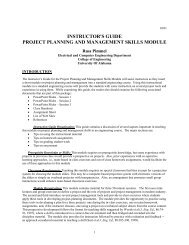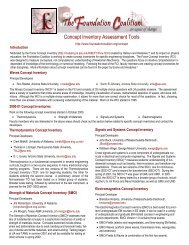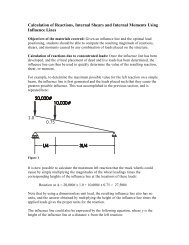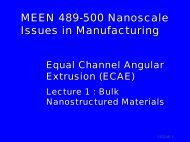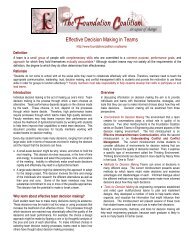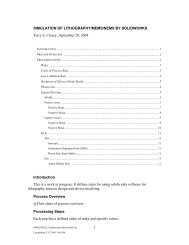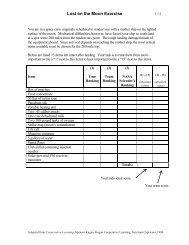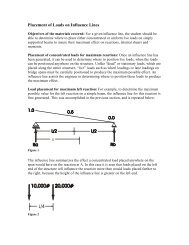Paper - Foundation Coalition
Paper - Foundation Coalition
Paper - Foundation Coalition
You also want an ePaper? Increase the reach of your titles
YUMPU automatically turns print PDFs into web optimized ePapers that Google loves.
BRENDA BRIDGES - 2002-Jun-07_Stern_and_Pimmel_paper.doc Page 3<br />
Session<br />
d) Engineers have ethical responsibilities concerning the<br />
public’s safety which are more stringent than legal 3)<br />
obligations. The technical complexity of issues within<br />
our profession, coupled with rapid changes in<br />
technology, mean that the public cannot be protected<br />
through explicit laws alone, since the laws cannot<br />
always be current enough or provide sufficient detail to<br />
handle all relevant situations and still encourage<br />
responsible innovation. Development of and adherence<br />
to a professional code of ethics is therefore necessary.<br />
Enforcement of the code is often accomplished through<br />
peer pressure and a civil court system which uses<br />
professional peers to advise juries concerning<br />
reasonable engineering practices . (Objectives #5 and<br />
#7)<br />
4)<br />
Additional concepts include an engineer’s responsibility to<br />
his or her employer, gauging a company’s culture to<br />
determine its commitment to public safety, and determining<br />
when whistleblowing is acceptable or even imperative.<br />
There are many safety-related cases which are newer<br />
than the Ford Pinto (in particular the cases of the vulnerable<br />
Chevy S10 saddlebag-style gas tanks and the problems with<br />
Firestone tires on the Ford Explorer), and these newer cases<br />
may be more familiar and feel more contemporary to the<br />
students. Nevertheless, we chose the Ford Pinto case<br />
because it has the following unique features.<br />
1)<br />
The cost-benefit analysis was clearly spelled out and<br />
explicitly performed. In an internal memorandum, Ford<br />
used a $200,000 per life lost figure (from an NHTSA<br />
study) to justify not repairing the problem. Students<br />
should at first be appalled that such an analysis was<br />
performed, then, through discussion of the first and<br />
second questions above, they should see that as a<br />
society we often perform cost-benefit analyses<br />
involving lives. Differentiation between a company<br />
analysis and a societal analysis should help students<br />
understand the societal impact of engineering, to<br />
appreciate the need to inform society of the technical<br />
consequences of various engineering solutions, and to<br />
gain an informed societal consent prior to<br />
implementation.<br />
Upper management at Ford, in particular Lee Iacocca, had a<br />
technical background (Bachelor’s in Industrial<br />
Engineering from Lehigh University, Master’s in<br />
Engineering from Princeton). This robs the student of<br />
any comfortable feeling that the problem may only<br />
have occurred because management did not<br />
understand the technical issues or have the training<br />
necessary to perform a sound scientific assessment.<br />
The instructor should still note that in many cases<br />
management does not have a technical background<br />
and that part of an engineer’s ethical responsibility is<br />
to make sure that management understands the<br />
technical issues.<br />
The purely legal mechanisms of regulation and the criminal<br />
justice system were both used in the Ford Pinto case,<br />
and were insufficient to safeguard the public. As part<br />
of the pre-class reading assignment, students are<br />
informed of the State of Indiana’s negligent homicide<br />
trial of Ford4, which ended in acquittal, possibly due to<br />
the high burden of proof rightfully required in a<br />
criminal proceeding. As also discussed in the assigned<br />
pre-class reading (and in Question #6), establishment<br />
of regulations is a slow, drawn-out procedure which<br />
can be either insufficiently responsive to safeguard the<br />
public or else can be over-encompassing and stifling to<br />
responsible innovation. The Ford Pinto case shows<br />
that criminal law and regulations alone are<br />
inappropriate to balance the public’s interests in safety<br />
and responsible innovation, hence one of the needs for<br />
ethical obligations.<br />
Developing a Code of Engineering Ethics<br />
This second session addresses Objectives #2, #4, and #6.<br />
As a pre-assignment for the second session, each student<br />
group is tasked with developing its own engineering code<br />
of ethics. The students are specifically told NOT to read<br />
any professional organization’s codes prior to doing their<br />
work, but to develop their own codes based on the first<br />
session’s case study (concerning large, societal issues) and<br />
based on their own experiences (concerning smaller,<br />
4 The following paragraph is included in the student’s reading assignment:<br />
“Some legal background: Most of the lawsuits against Ford were civil suits for actual and punitive damages, but one case<br />
involved criminal charges. In Indiana a rear-end collision between a van and a Pinto caused a fire which killed three teenage<br />
girls in the Pinto. Ford was subsequently tried in Indiana on the criminal charge of negligent homicide (this is the trial<br />
mentioned in the … web page). There were no accompanying civil suits for this particular incident because, at the time,<br />
Indiana law severely limited the amount of damages which a parent could recover for the death of a minor child (no punitive<br />
damages were allowed and actual damages were limited to the lost wages which the minor might have earned in the time<br />
between his/her death and age 18). Many argue that Ford was acquitted of the negligent homicide charge because the<br />
standard of proof in a criminal charge is much higher than the standard of proof in a civil charge (reasonable doubt vs. a<br />
preponderance, or balancing, of the evidence). The most damaging civil case against Ford was Grimshaw vs. Ford, a<br />
California case in which a jury awarded $150 million in punitive damages (later reduced to $6 million on appeal).”<br />
0-7803-7444-4/02/$17.00 © 2002 IEEE November 6 - 9, 2002, Boston, MA<br />
32 nd ASEE/IEEE Frontiers in Education Conference<br />
3




